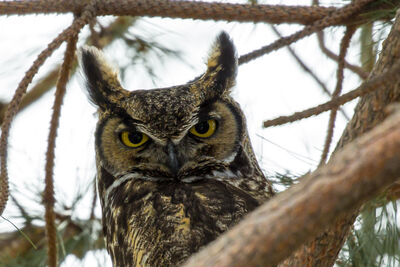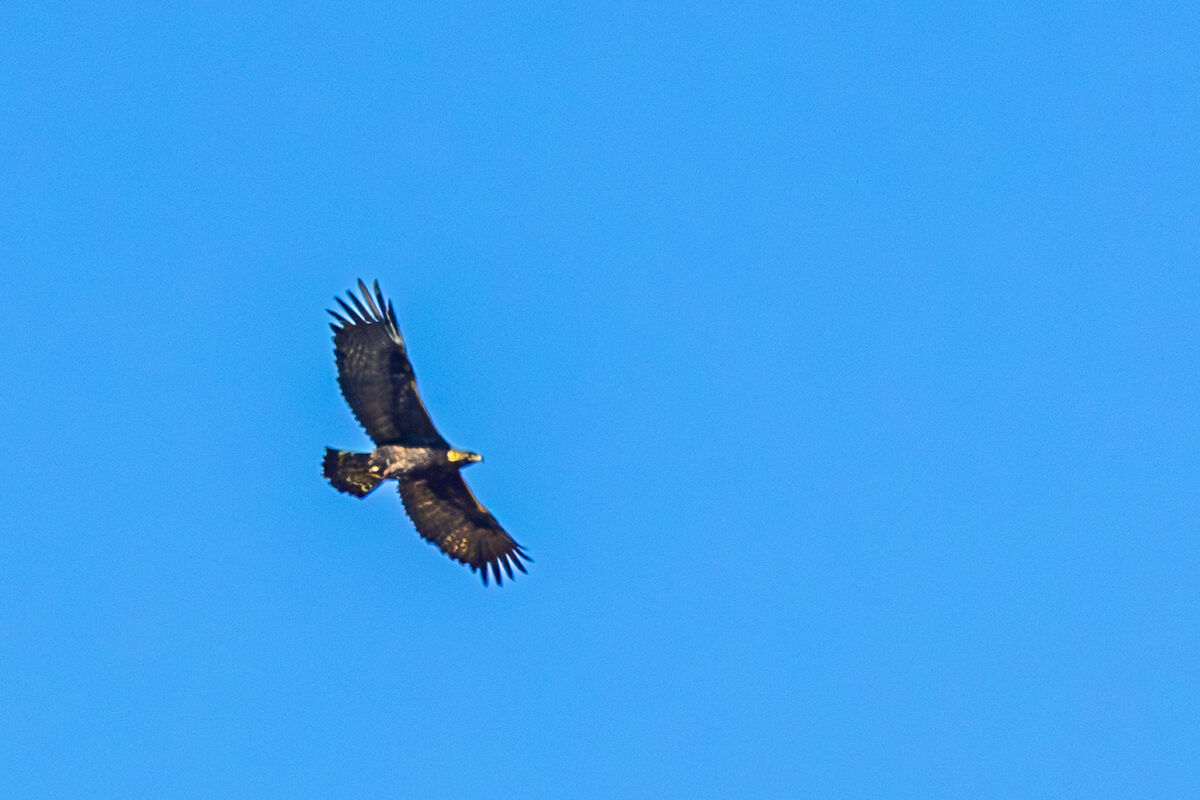Bird at Great Distances Never Sharp
Mar 19, 2024 02:41:16 #
Greetings,
This is my first ever post in the Photo Analysis section. I’m mostly a bird photographer. I’ve noticed that when a bird is very far away, my photos aren’t sharp. I’m wondering if this is inherent to shooting at such great distances? Or is it an inevitable result of heavy cropping? Something else?
I shoot a Canon R10 mirrorless. In this example, I photographed this distant Golden Eagle using my C1 setting:
1/2500, AI Servo, auto ISO, and animal eye tracking. The result was:
1/2500 at f/5.6, ISO 800, 400 mm
I ran Denoise on the photo in Lightroom Classic, and added a mask and made some adjustments to the eagle.
As you can see, the eagle is not at all sharp. It doesn’t seem noisy to me. Just kind of a jagged mess.
Are there steps I could take to improve shots like this? Or am I just brushing up against technological limits and/or my own PP limits?
Thanks for any thoughts.
This is my first ever post in the Photo Analysis section. I’m mostly a bird photographer. I’ve noticed that when a bird is very far away, my photos aren’t sharp. I’m wondering if this is inherent to shooting at such great distances? Or is it an inevitable result of heavy cropping? Something else?
I shoot a Canon R10 mirrorless. In this example, I photographed this distant Golden Eagle using my C1 setting:
1/2500, AI Servo, auto ISO, and animal eye tracking. The result was:
1/2500 at f/5.6, ISO 800, 400 mm
I ran Denoise on the photo in Lightroom Classic, and added a mask and made some adjustments to the eagle.
As you can see, the eagle is not at all sharp. It doesn’t seem noisy to me. Just kind of a jagged mess.
Are there steps I could take to improve shots like this? Or am I just brushing up against technological limits and/or my own PP limits?
Thanks for any thoughts.
Mar 19, 2024 06:21:27 #
globetrekker wrote:
Greetings, br br This is my first ever post in th... (show quote)
You answered your own question. Get closer. Crop less.
Mar 19, 2024 08:37:33 #
TRY lower iso , like 250 , also you will need lower speed to compensate . If you can hand held without shakes , you could shoot at 500 or less . For birds , an 800mm lens does better .
Mar 19, 2024 09:20:52 #
Every lens has its own "sweet spot", mine are never near infinity, but by design are much closer. Therefore I wait till I see the whites of their eyes or something similar. This avoids the frustration you are wrestling with as I have before adopting a better plan. I am sure the lenses in our satellites are designed for infinity rather exclusively.
Mar 19, 2024 09:57:42 #
mikeroetex wrote:
You answered your own question. Get closer. Crop less.

 in addition to cropping, and higher ISO degradation, there also may be atmospheric degradation .
in addition to cropping, and higher ISO degradation, there also may be atmospheric degradation .If you can get your ISO down and no subject speed blurring, you can use AI pixel enlargement software to mitigate the cropping.
Mar 19, 2024 12:29:45 #
Longer lens or get closer. While cropping does increase noise as we all know…the real problem with distant subjects is a phenomenon known as POD for pixels on duck. For a given sensor and lens…the farther away the bird is the fewer POD you get and details smaller than a single pixel simply cannot be resolved.
Upscaling the image using some of the latest AI enabled software like Gigapixel or LR or whatever •may• increase the apparent detail, but mostly they're just making up data…it's intelligently made up data I agree but still essentially made up/interpolated.
Upscaling the image using some of the latest AI enabled software like Gigapixel or LR or whatever •may• increase the apparent detail, but mostly they're just making up data…it's intelligently made up data I agree but still essentially made up/interpolated.
Mar 19, 2024 12:32:18 #
Do telephoto zoom lenses tend to be soft at or near their maximum focal length? Yes.
Does cropping increase softness (and noise)? Yes.
Does distance (i.e. lots of atmosphere) make for soft images? Yes.
Does increasing the focal length increase the need for fast shutter speeds, and does using shutter speeds that are insufficiently fast at long focal lengths make for soft images? Yes.
Does using very high ISOs cause softness? Yes
You yourself will have to decide which of the above are relevant to you. If you never get sharp images, the lens may be at fault.
Does cropping increase softness (and noise)? Yes.
Does distance (i.e. lots of atmosphere) make for soft images? Yes.
Does increasing the focal length increase the need for fast shutter speeds, and does using shutter speeds that are insufficiently fast at long focal lengths make for soft images? Yes.
Does using very high ISOs cause softness? Yes
You yourself will have to decide which of the above are relevant to you. If you never get sharp images, the lens may be at fault.
Mar 19, 2024 13:08:30 #
Thanks, everyone. Very educational. In situations like these, which actually aren't that common for me, getting closer is not an option. I could try to lower the ISO, but I'm not sure the corresponding lower shutter speed would be worth the trade-off. And I'm not convinced ISO is an issue here. It's not that high. I looked at some recent photos of hawks in flight (MUCH closer to than my eagle example), and they have ISO in the 500-1000 range but are sharp. It seems that great distances and resulting POD, heavy cropping and atmospheric degradation all combine to make these shots beyond my current gear and PP capabilities.
Mar 19, 2024 14:06:58 #
cahale
Loc: San Angelo, TX
globetrekker wrote:
Greetings, br br This is my first ever post in th... (show quote)
ISO 800 and f5.6. Too much of one and not enough of the other. Cropped? Focus at long distance may be on something else that you didn't see.
Mar 19, 2024 23:42:06 #
KolorFotoBug
Loc: Massachusetts
Another variable that cannot be controlled is refraction of light by the atmosphere which can destroy sharpness. This is the same phenomenon that causes the wavy distortion seen in mirages but to a lesser extent than your situation.
Mar 20, 2024 06:38:55 #
mikeroetex wrote:
You answered your own question. Get closer. Crop less.
Yes, use a helicopter or hot air balloon to get closer... What???
The image was downloaded, cropped, and cleaned with AI Topaz Denoise, and Sharpen. The contrast was improved as well as the color tweak with Topaz Clarity. Then to up the resolution Topaz Gigapixel was employed at 2x.
Comments, please
Mar 20, 2024 07:59:31 #
KolorFotoBug
Loc: Massachusetts
Can't comment on any of the photo editing software you mentioned since I don't use them. Is it possible that it is being overprocessed.?
Mar 20, 2024 09:10:36 #
R.G. wrote:
Do telephoto zoom lenses tend to be soft at or nea... (show quote)
Great list of "Causes" R.G.
I still remember how disappointed I was when I got my Canon 28-300 mm zoom and shot a cow about 1300 ft away on a hot summer day.
Between the moisture (blue haze) in the air and the heat rising in waves, the picture was not pretty.
Sometimes it is not equipment of operator error . . .
Best Wishes,
JimmyT Sends
Mar 20, 2024 09:54:18 #
BobPeterson
Loc: Massachusetts
dpullum wrote:
Yes, use a helicopter or hot air balloon to get closer... What???
The image was downloaded, cropped, and cleaned with AI Topaz Denoise, and Sharpen. The contrast was improved as well as the color tweak with Topaz Clarity. Then to up the resolution Topaz Gigapixel was employed at 2x.
Comments, please
The image was downloaded, cropped, and cleaned with AI Topaz Denoise, and Sharpen. The contrast was improved as well as the color tweak with Topaz Clarity. Then to up the resolution Topaz Gigapixel was employed at 2x.
Comments, please
No better just different.
Mar 20, 2024 17:45:32 #
BobPeterson wrote:
No better just different.
Larger and more detailed compared to the original. When using deNoise and sharpen the screen is divided and you can see the difference... so "No Better" is not a correct comment. I could do a shot of the difference of the cropped "make it look nearer" and the cleaned-up photo. I was trying to answer the "how-to-use" section question.
Regarding the over-processing accusation, the original photo had white edges and lots of noise ... The revised photo is much better and any imperfections are based on the starting image.
If you think it was over processed state what you are basing your claim on... I suspect wet finger in the air... Prove me wrong and educate me.
SOOC people are behind times thinking modern AI software does not make a significant difference. SOOC wallow in yesterday's technology.
If you want to reply, then register here. Registration is free and your account is created instantly, so you can post right away.







